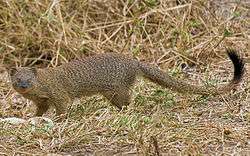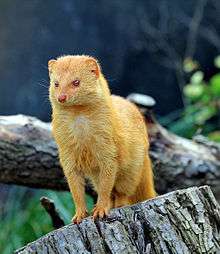Slender mongoose
| Slender mongoose | |
|---|---|
 | |
| From Serengeti National Park | |
| Scientific classification | |
| Kingdom: | Animalia |
| Phylum: | Chordata |
| Class: | Mammalia |
| Order: | Carnivora |
| Family: | Herpestidae |
| Subfamily: | Herpestinae |
| Genus: | Galerella |
| Species: | G. sanguinea |
| Binomial name | |
| Galerella sanguinea Rüppell, 1836 | |
 | |
| Slender mongoose range | |
The slender mongoose (Galerella sanguinea), also known as the black-tipped mongoose or the black-tailed mongoose, is a very common species of mongoose of sub-Saharan Africa.[2]
Range and habitat
The slender mongoose, with up to fifty subspecies, are found throughout sub-Saharan Africa, with the black mongoose of Angola and Namibia sometimes considered a separate species. They are adaptable and can live nearly anywhere in this wide range, but are most common in the savannah and semiarid plains. They are much rarer in densely forested areas and deserts.
Description

As the name suggests, the slender mongoose has a lithe body of 27.5–40 cm (11–16 in) and a long tail of 23–33 cm (9–13 in). Males weigh 640–715 g (22–25 oz), while the smaller females weigh 460–575 g (16–20 oz).
The color of their fur varies widely between subspecies, from a dark reddish-brown to an orange red, grey, or even yellow, but these mongooses can be distinguished from other mongooses due to the prominent black or red tip on their tails. They also have silkier fur than the other African members of their family.
Behavior
The slender mongoose generally lives either alone or in pairs. It is primarily diurnal, although it is sometimes active on warm, moonlit nights. It doesn't seem to be territorial, but will nevertheless maintain stable home ranges that are often shared with members of related species. Indeed, the slender mongoose and these other species may even den together, as most of their relatives are nocturnal. Dens may be found anywhere sheltered from the elements: in crevices between rocks, in hollow logs, and the like.
Reproduction
A male's range will include the ranges of several females, and scent cues inform him when the female is in heat. The gestation period is believed to be 60 to 70 days, and most pregnancies result in one to three (usually two) young. The male does not help care for them. Unusually, for a solitary species, in the Kalahari the males are philopatric whereas the females disperse.[3] This is thought to be due to the benefits of kin cooperation by males in defence of females.
Feeding
The slender mongoose is primarily carnivorous, though it is an opportunistic omnivore. Insects make up the bulk of its diet, but lizards, rodents, snakes, birds, amphibians, and the occasional fruit are eaten when available. It will also eat carrion and eggs. As befits the popular image of mongooses, the slender mongoose is capable of killing and subsequently eating venomous snakes, but such snakes do not constitute a significant portion of its diet.
Slender mongooses are more adept at climbing trees than other mongooses, often hunting birds there.
Conservation
The slender mongoose has been targeted by extermination efforts in the past, due to its potential to be a rabies vector and the fact that it sometimes kills domestic poultry. These efforts have not been conspicuously successful, although some subspecies may be threatened.
Overall, the slender mongoose is in no immediate danger of extinction, and the IUCN Red List evaluated it as least concern.
References
- ↑ Hoffmann, M. (2008). "Herpestes sanguineus". IUCN Red List of Threatened Species. Version 2014.2. International Union for Conservation of Nature. Retrieved 24 July 2014. Database entry includes a brief justification of why this species is of least concern
- ↑ Wozencraft, W.C. (2005). "Order Carnivora". In Wilson, D.E.; Reeder, D.M. Mammal Species of the World: A Taxonomic and Geographic Reference (3rd ed.). Johns Hopkins University Press. pp. 565–566. ISBN 978-0-8018-8221-0. OCLC 62265494.
- ↑ Graw, B.; Lindholm, A.K.; Manser, M.B. (2016). "Female-biased dispersal in the solitarily foraging slender mongoose, Galerella sanguinea, in the Kalahari". Animal Behaviour. 111: 69–78. doi:10.1016/j.anbehav.2015.09.026.
External links
| Wikimedia Commons has media related to Galerella sanguinea. |
| Wikispecies has information related to: Galerella sanguinea |
